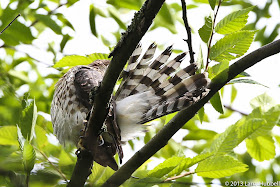A Cooper's Hawk is an impressive, medium to small-sized bird of prey. The females are larger than the males. The smaller male can be easily mistaken for a female Sharp Shinned Hawk. (You can learn more about how to tell them apart by clicking HERE.)
This bird is a juvenile (notice the yellow eyes and striped chest) that recently learned to fly. It is so young that it still depends on its parents for food. The bird is in fact begging for something to eat. Last week Ed Deal pointed out this begging sound, which is very different than the "normal" cry of a Cooper's Hawk. As a matter of fact learning the difference between the begging of the young birds and the normal "Kuk, Kuk, Kuk" makes it much easier to find them. For a just few more weeks young Cooper's will be depending on their parents for food, so this is a good time to know and listen for their calls. The Cornell Lab has a number of excellent recordings. (Click HERE to learn more.)
In this photo one of the young hawks stopped to call for more while eating the prey the parents provided.
Ed suggests this is an attempt to mislead its siblings. If they hear this bird is asking for more the siblings won't realize there is food available. You can also see the bird is mantling the prey just a bit. Mantling means spreading its wings to hide the prey while it feeds. When feeding on larger prey these birds will spread their wings much wider. Maybe this habit also comes from not wanting others to see and steal their food.
This week's story is focused on the exceptional tail of a Cooper's Hawk. These birds spend the majority of the lives hunting in and among the leaves and branches of bushes and trees. (This is very different from the Red-Tailed Hawks you see sitting on the light poles above I-5 or the 520 Eagles.) The Cooper's long tail can be spread wide to help slow them down quickly or turned vertical to help them turn left or right on a dime. Take one more look at the first photo above. Where is the end of the birds tail? It looks like it stops right around those green leaves, right?
In this close up from the same photo you can see the tail feathers extend below the leaves, even though they are partially obscured.
Speaking of obscured and hunting in trees can you see the Cooper's in this photo?
Blending in is one of the tools of the trade.
The next photo shows how the tail and the wings can be used among the tree branches.
Still hungry.
Did you notice there were two birds in this photo? Did you see the red band on the leg? These are two young females that Ed banded. Ed puts red bands on the right legs of females and purple bands on the left legs of males. If you happen to photograph one of these birds Ed would love to know the letter & number on the band, plus the location and date. If you leave a message in the comments below I will pass it on.
Another way to see the tail of a Cooper's is to watch it while it cleans its tail. Here is an interesting little sequence.
That last photo was just a split second after the last tail feather slipped out of the bird's beak.
Did you notice the white fluffy feathers at the base of the tail? These under-tail coverts seem like the only sign of softness in this hunting machine.
This week when you are out and about watch (and listen) for the young Cooper's. They will certainly be watching for you.
Have a great day on Union Bay...where nature lives in the city!
Larry
ps: Happy Birthday, Brad!












Thank you! :)
ReplyDeleteYou are welcome!
DeleteRegarding the rat vs. muskrat question posed re photo in conversation on west side of Arboretum 8/10: another possibility is... Nutria.
ReplyDeleteThanks for the Cooper's info!
JW
Looking at the photos I am sure you are right. It was a Muskrat. I have seen a Nutria before (but not on Union Bay) and it was much larger than the Muskrat. Thanks for your help!
Delete